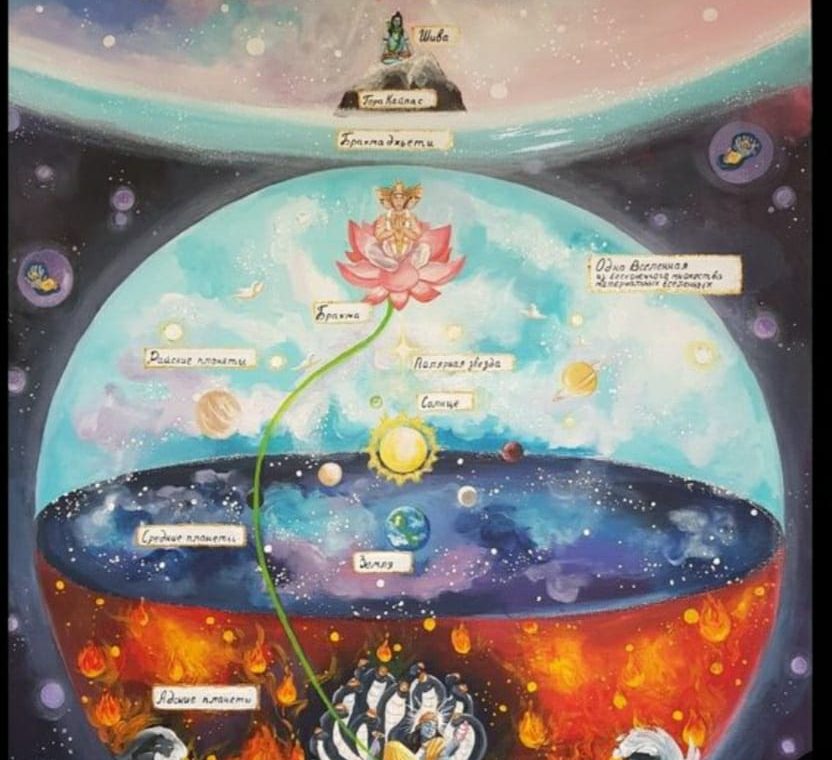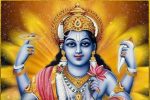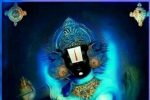NAME 56
Śāśvataḥ शाश्वतः
Śāśvata means eternal. This is yet another quality of the Brahman. Brahman is beyond time and space and therefore, He is beyond modifications. Modification happens only if one is bound by time and space. Time is the essence of all changes that happens in the universe. The entire creation originates from Him and dissolves unto Him and in spite of this He remains the same.
Nārāyaṇa sūktaṁ (3) says, “śāśvatam śivam acyutam” which means that Nārāyaṇa is permanent, auspicious and unchanging. One of the names of Viṣṇu is Acyutan, meaning unchanging – He is Everlasting
Shaasvatah means someone who is perennial and everlasting. In the words of Sri Adi Sankara ‘Shashvat sarveshu kaaleshu bhavati iti Shaashvatah – He exists at all times’.
‘Patim Vishvasyaatmesvaram Shaashvatam Shivam Achyutam
Narayanam Mahagyeyam Vishvaatmanam Parayanam’
Maha Naarayana Upanishad (MNU 13 verse 3)
Meaning: He is the protector of the Universe and the Ruler of the individual souls; He who is permanent and supremely auspicious and unchanging. He is the in-dwelling spirit who is supremely worthy of being known, who is the embodiment of the Universe and who is the Supreme goal.
Dhyana Shlokam of Rudram says ‘Nityam cha Shaashvatam Shuddham Dhruvam Aksharam Avyayam’
Swami Chinmayananda points out that for something to be permanent, it has to be changeless over Time, and Bhagavan is the controller of time, and is not controlled or affected by time, and so He is eternal and permanent.
५६. ॐ शाश्वताय नमः |
56. OM Śāśvatāya Namaḥ
Saasvatah -That which remains at all times the same is the Permanent, That which is permanent, should remain Changeless in all the three periods of time. In short, He is unconditioned by time. The Supreme Consciousness Itself is the very Illumminator of Time, and the Illuminator can never be affected by what It illumines. This changeless reality is Vishnu.
INTERPRETATION GUIDED BY SANT VANI (WORDS OF SAINTS)
Śāśvataḥ
The ever existent.
He is Śāśvatah, because śaśvat means, he exists always, in all the three periods of time. The Mahānārāyaṇopaniṣad talks of Him as śāśvata śivam acyutam’ (13.1). Īśvara in His saguṇa aspect also is Śāśvata, because He is manifest in the form of the world. Then Īśvara with the world goes into an unmanifest state. So, Īśvara is there when the world is resolved into an unmanifest state and He is also there when the world is manifest.
So what if the Lord is ever existent? We look into this, with a verse in the Gita where Bhagavan teaches the atma, “I” to be ever existent. A lot of our fears stem from a sense of loss. The loss of a favourite toy for a 5 year old child is as real and painful as the loss of a friend for a 20 year old or the loss of one’s teeth for a 70 year old. any people say, “ I am not afraid of death but I am afraid of losing loved ones. I am afraid of losing my health or a particular person.” All fears based on a sense of loss, are centred on the mind-body-sense complex as they are taken to be real. Please note the use of the word, sense of loss, not real loss. I use the word sense of loss because it is experienced subjectively, not universally. Someone may be happy to lose one‘s partner following a difficult marriage as he wants to get married to another person. But the one who was subject to divorce proceedings, may experience a sense of loss. So sense of loss is subjective.
“That is not to say that people don’t love each other or that this is a false world, it’s just that it’s all temporary and transient. There are absolutely no guarantees. Reminding yourself of it will help you walk the path of dharma. It will give you the strength to make right choices and speak right words. And the more righteous your life, your conduct, the greater peace you experience at heart. It’s that simple, really.” – Om Swami
BHAJ GOVINDAM
The sense of loss and fear is also highlighted by Bhaja Govindam, a beautiful text that helps to convert a samsāri into a mumukshu. In one of the verses, Sankaracharya, speaks about how things change one after the other – spring into summer, day into night and so on. Time has its play but the winds of desire continue to plague the person who has not yet discerned the limitations of his pursuits. The samsari, identified as he is, with the mind-body continues to be affected and tossed about by different circumstances and all because of the play of time. And the important thing, is, that he does not want to be affected.
Please read for deeper understanding
https://os.me/learn-to-let-go-bhaj-govindam-56/
https://os.me/bhaja-govindam-surrender-meditate-and-be-liberated-66/
We saw earlier that satyam is that absolute reality which cannot be negated. That which always is. The physical body is subject to changes- birth, existence, growth, modification, decline and death.
Due to lack of our understanding, the physical body is taken to be me. The viveka required here is that the body is subject to change, the atma is not subject to any change in any way. Body belongs to this Atma. Atma is not the body.
In the Gita, 2.20, Bhagāvān says that the atma is never born, nor does it die. It is not that, having been, it ceases to exist again. The Atma is unborn (ajaḥ), eternal (nitya), undergoes no change whatsoever (śāśvataḥ) and is ever new (purāṇaḥ). When the body is destroyed; Atma, I is not destroyed. This being the goal for our understanding, we prepare ourselves through a life style of karma yoga. Karma can be yoga only if Ishvara and his reality is understood.
From the standpoint of Īśvara, He is Śāsvata, eternal, and from the standpoint of His essential nature as saccidānanda-brahma also, He is Śāsvata, timeless.
He who is “unchanged” and ‘permanent’ at all times. Beyond the limitations of Time, who is constantly ‘active’ but still unchanging and eternal…
The whole world is in a state of unbroken flux, constantly changing – birth-death-birth, decay, destruction, growth, building & rebuilding… constant action and change is what is seen in the world around us but “He” is unchanged and permanent – Śāśvata – like the screen on which a movie is played – the same screen but different moving images…
The three key actions of the supreme being, namely Creation, Sustenance, and Destruction happen in a continuous and consistent stream but ‘He’ despite all the “action’ remains unchanged, unchangeable, unmoved, immutable, and permanent – this is what sets him apart from everything else – Therefore he is part of his creation as well as apart from it.
In the विवेकचूडामणि (Vivekachudamani), the Ātman is identified as Śāśvata.
अजो नित्यः शाश्वत इति ब्रूते श्रुतिरमोघवाक् ।
तदात्मना तिष्ठतोऽस्य कुतः प्रारब्धकल्पना ॥ ४५९ ॥
विवेकचूडामणि
ajo nityaḥ śāśvata iti brūte śrutiramoghavāk |
tadātmanā tiṣṭhato’sya kutaḥ prārabdhakalpanā || 459 ||
“The Śrutis declare that the Ātman is birthless, eternal and undecaying. To such a person no Prārabdha accumulates”
That the Ātman is an inseparable aṁșā of the Paramātmān is an undeniable truth and therefore the Paramātmān is Śāśvata.
In the Bhagavad-gītā too, the reference to the Supreme being being the eternal protector of the Śāśvata-dharma (Sanātana dharma) is revealed – he who is the protector of the Dharma that is Śāśvata has to be necessarily be Śāśvata himself – this is an interesting way of showing how this Dharma is truly Sanātana as it comes directly from he who himself is Sanātana and Śāśvata.
त्वमक्षरं परमं वेदितव्यं
Bhagavad Gita: Chapter 11, Verse 18
त्वमस्य विश्वस्य परं निधानम् |
त्वमव्यय: शाश्वतधर्मगोप्ता
सनातनस्त्वं पुरुषो मतो मे || 18||
tvam akṣharaṁ paramaṁ veditavyaṁ
tvam asya viśhvasya paraṁ nidhānam
tvam avyayaḥ śhāśhvata-dharma-goptā
sanātanas tvaṁ puruṣho mato me
“I recognize you as the supreme imperishable being, the ultimate truth to be known by the scriptures. You are the support of all creation; you are the eternal protector of sanātan dharma (the eternal religion); and you are the everlasting Supreme Divine Personality.“



